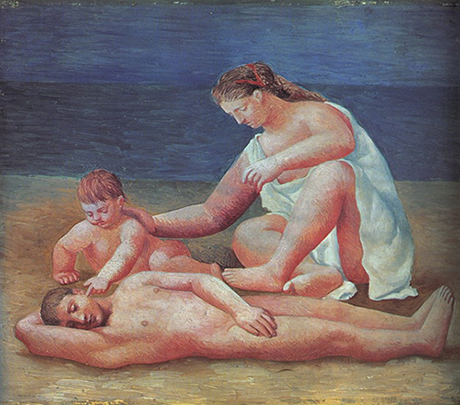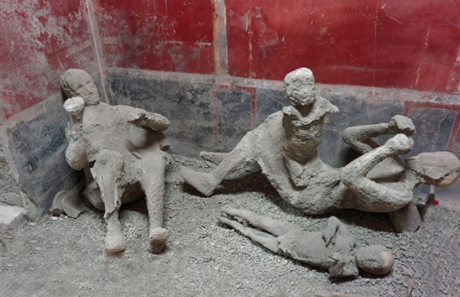It is generally agreed that the archaic Lespugue figure also inspired Picasso’s sculpture of a fertility goddess holding a vase or lamp that now marks his grave in the grounds of Château de Vauvenargues. Picasso originally created the sculpture in 1933 as a homage to Marie-Thérèse and, as a synthesis of the Venus of Lespugue and Mary Magdalene, she fittingly implies both renewal and redemption. Circuitous as this route may be it establishes Marie-Thérèse’s presence on the title page. Also, since much of Picasso’s work is autobiographical, it is not, therefore, unreasonable to assume that the reclining male figure to the left of Marie-Thérèse in archaic form is a self-portrait and the diminutive figure is Picasso and Olga’s son Paulo; Maya, the daughter he fathered with Marie-Thérèse, was not born until 1935.
Family on a beach was a theme that Picasso had visited previously and is best exemplified by Family on a Beach, 1923, which also depicts a man, a child and a woman on a beach (Fig. 15). This composition sits within Picasso’s post Naples-Pompeii neo-classical approach to painting, both in terms of its inflated sculptural forms and its terracotta colour. He visited both in 1917 in the company of Serge Diaghilev, Jean Cocteau, Léonide Massine and Igor Stravinsky. His son Paulo was born in 1921, which once again suggests that this family scene has an autobiographical context. The distinctively stiff reclining male figure appears ambiguously frozen between sleep and death, which is evocatively suggested by the way that his hand covers his genitalia. Picasso normally took great joy in exaggerating this part of the male anatomy; the loss of which, for him, signified death. This is abundantly portrayed in his post impotency paintings produced during the last years of his life. The baby boy’s tender touch on his father’s face, to either awake or revive him, highlights the father’s sadness or possibly even his demise. When he met the 17 year old Marie-Thérèse Walter in early January 1927 his marriage to Olga had imploded and although not officially separated he signalled his unhappiness in paintings such as Family on a Beach. It was never exhibited or photographed during his lifetime, which suggests it held a very personal significance for him. In many respects its eerie sombre atmosphere conjures up the moment when the Pompeian families tried to comfort and shield each other form the impending cataclysm caused by the volcanic eruption of Vesuvius in 79 A.D. (Fig.16).
 15
15 16
16Fig.15 Picasso. Family on a Beach, painting, 1923
Fig.16 Family overcome by hot volcanic ash, post eruption Pompeii 79 A.D.